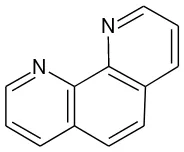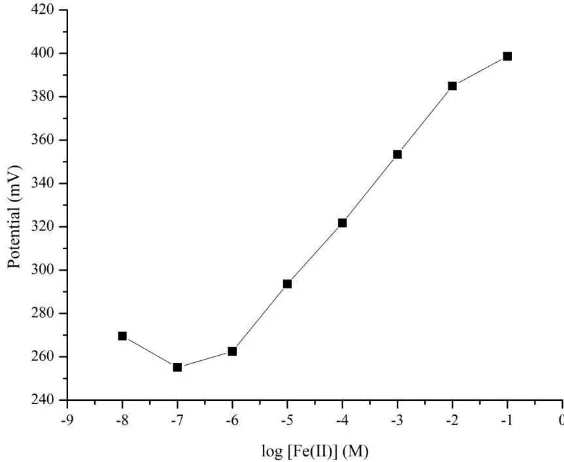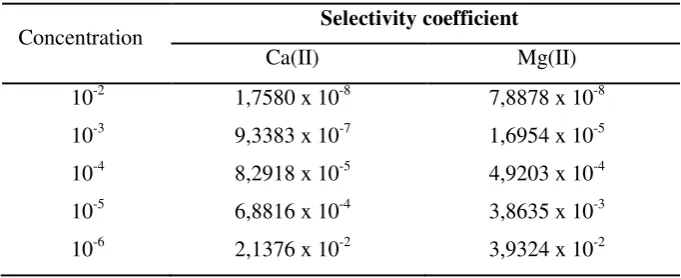DEVELOPMENT OF Fe(II)-SELECTIVE SOLID MEMBRANE ELECTRODE BASED ON 1,10-PHENANTHROLINE LIGAND
Suyanta*, Sunarto, Susila Kristianingrum, Astri Asmawati, Nur Indah Wardani Department of Chemistry Educations, Faculty of Sciences and Mathematics,
Yogyakarta State University, Yogyakarta 55281, Indonesia Email: suyanta@uny.ac.id
The development of ion selective electrode based on 1,10-phenanthroline has been constructed for determination of Fe(II). The electrode was fabricated using 1,10-phenanthroline, KTCpB, DBP, PVC (6.73% : 3.33% : 60% : 30%) and THF. The Nernst factor, concentration range, detection limit, response time and selectivity of the membrane electrode are described.
The membrane electrode exhibited good response for Fe(II). in a wide concentration range from 1 × 10-6 M to 1 × 10-2 M with a slope of 30.37 mV/decade of Fe(II) concentration. The electrode has a detection limit of 7.902 × 10-7 M with response time 15 second. Furthermore, the electrode generated constant potentials in the pH range of 2.5-8.0 without interference from Ca(II) and Mg(II)ions.
The developed electrode was used for quantification of Fe(II) in underground water samples and the results were in good agreement with those obtained with an UV-Vis spectrophotometric method.
Keywords: Fe(II)-selective electrode, 1,10-phenanthroline ligand, membrane electrode, potentiometry
1. Introduction
Iron is one of the most prominent elements in environment and biological systems. It is widely distributed at many various concentration levels throughout the environment (Zamani et al., 2008). Iron is known to possess diverse functions in biology and medicine. For human being, iron plays a significant role in the oxygen transport, storage, and in the transfer electron. The absence of iron causes anemia, the result of decreased red blood cell content (Moghadam, Shabani, & Dadfarnia, 2011). Moreover, iron is considered as toxic element because the excess amount of iron in human body can lead to serious problems including depression, rapid and shallow respiration, coma, and cardiac arrest (Zamani et al., 2012). The monitoring of amount of iron in various experimental samples is important. Therefore, the highly selective analytical methods are required for the determination of iron various experimental samples (Bandi, Singh, & Upadhyay, 2014).
concentration range, low pH range, and low selectivity. Thus, a more sensitive and selective electrode with good performance for determination of Fe(II) is required.
In this study, the ion selective electrodes (ISEs) based on solid membrane with 1,10-phenantroline (Figure 1) was used to develop a Fe(II) ion-selective electrode. The 1,10-phenantroline ligand shows complexation with Fe(II), which indicates high affinity of
Fe(II). The performance characteristics of developed Fe(II) ion selective electrode based on 1,10-phenantroline were investigated and used for determination of Fe(II) in real samples.
N
[image:2.595.262.354.201.277.2]N
Figure 1. Structure of 1,10-phenanthroline
2. Experimental 2.1 Materials
High molecular weight poly(vinyl chloride) (PVC) was obtained from Fluka Chemica (Switzerland), dibutylphthalate (DBP), potassium tetrakis chlorophenyl borate (KTCpB), tetrahydrofuran (THF) were obtained from Merck (Germany). 1,10-phenantroline was obtained from Aldrich (Germany).Hydrochloric acid (HCl), sodium hydroxide (NaOH), potassium chloride (KCl), magnesium chloride (MgCl), calcium chloride (CaCl2), were prepared prepared standardized according to appropriate methods. Stock solution of Fe(II) ion were freshly prepared by dissolving appropriate amount of iron(II) sulphate pentahydrate in deionized water.
2.2 Instruments
The potential measurement was carried out on a pH/milivolmeter Orion 70A, Mass (USA). A Ag|AgCl electrode of BaSi, MF-2052 (USA) with a fiber junction was used as a reference electrode. The pH value was determined by using Orion, 915600, Mass. (USA) glass-pH electrode. Metal ion was analysed using UV-Vis Spectrophotometer.
2.3 Electrode preparation
The membranes were prepared by dissolving with an appropriate of PVC, 1,10-phenantroline, KTCpB, and DBP with THF solvent. Then, silver wire was dipped in the solution of membrane until membrane coated on surface silver wire. The electrodes were conditioned in 1 × 10-3 M FeSO4.
2.4 Potential Measurements
measurement was the type of:
Ag/AgCl/KCl (satd):3MKCl∶∶sample solution ∥ membrane ∥ Ag
3. Results and Discussion
3.1 Potential cell and working concentration range
[image:3.595.148.430.318.549.2]The 1,10-phenanthroline ligand forms a stable complex with Fe(II) by coordination with nitrogen atom. The possible ion exchange mechanism at the membrane-solution interface of Fe(II) and 1,10-phenanthroline ligand that is responsible for the potentiometric response (Isa et al., 2013). The Fe(II)-selective electrode was prepared with composition of 1,10-phenanthroline (6.73%) : KTCpB (3.33%) : DBP (60%) : PVC (30%). The potential responses of the electrode were measured and the results are shown in Figure 2. The electrode exhibits a linear potential response over a wide concentration range from 1.0 × 10-6 M to 1.0 × 10-2 M of Fe(II) with a slope of 30.37 mV/decade and detection limit of 7.902 × 10-7 M.
Figure 2. Potential response of Fe(II)-selective electrode to various concentration of iron.
3.2 Effect pH
Figure 3. Effect of pH on the potential response of Fe(II)-selective electrode.
3.3 Response time of the electrode
The response time of the electrode is one of the most important factors in deciding the applicability of ion selective electrode. The practical response time was recorded by changing the Fe(II) solution with concentration from 1.0 × 10-6 M to 1.0 × 10-1 M. The response time recorded was less than 15 second.
3.4 Effect of interfering ions on electrode performance
Selectivity is the most important characteristic as it determines the extent of utility of any electrode in real sample measurements. The potential response of the electrode was monitored in the presence of interfering ions to assess the Fe(II)-selective electrode’s selectivity. The selectivity coefficient was measured by using the matched potential method (MPM) (Zamani et al., 2009). The result as given in Table 1, it can be seen that the proposed electrode is characterized by a high selectivity towards Fe(II) with respect to Ca(II) ion and Mg(II) ion.
Table 1. Selectivity coefficient of the Fe(II)-selective electrode for several concentration of Ca(II) and Mg(II)
Concentration Selectivity coefficient
Ca(II) Mg(II)
10-2 1,7580 x 10-8 7,8878 x 10-8
10-3 9,3383 x 10-7 1,6954 x 10-5
10-4 8,2918 x 10-5 4,9203 x 10-4
10-5 6,8816 x 10-4 3,8635 x 10-3
[image:4.595.127.468.586.725.2]3.5 Analytical Application
[image:5.595.109.487.221.309.2]The Fe(II)-selective electrode was applied for determination Fe(II) in some underground water samples. The results were compared with data obtained by an UV-Vis spectrophotometric method (Table 2). The data showed agreement between the data for determination Fe(II) using an UV-Vis spectrophotometric method and the Fe(II)-selective electrode. Therefore, the proposed electrode can be employed for Fe(II) quantification in real samples.
Table 2. Determination of Fe(II) in underground water samples by Fe(II)-selective electrode and by UV-Vis spectrophotometry.
Sample Fe(II)-selective electrode
(M) UV-Vis (M)
Sample 1 1,7344 x 10-6 1,289 x 10-6
Sample 2 1,3656 x 10-7 1,432 x 10-7
Sample 3 9,7169 x 10-7 1,092 x 10-6
4. Conclusion
The Fe(II)-selective electrode based on 1,10-phenanthroline was successfully developed for determination of Fe(II). It can be used to determine Fe(II) in a wide concentration range from 1.0 × 10-6 M to 1.0 × 10-2 M with detection limit of 7.902 × 10-7 M in pH range 2.5-8.0. The electrode was evaluated to the determination of iron in underground water samples with very good accuracy.
Acknowledments
The authors would like to thank the Directorate General of Higher Education, Ministry of National Education, Indonesia and Yogyakarta State University for financial supports. The author also thank to Prof. Gustan Pari, and Jaslin Ikhsan, Ph.D, for precious contributions.
References
Bandi, K. R., Singh, A. K., & Upadhyay, A. (2014). Construction and performance characteristics of polymeric membrane electrode and coated graphite electrode for the selective determination of Fe 3+ ion. Materials Science and Engineering: C, 36, 187-193.
Demir, E., Kemer, B., Bekircan, O., & Y Aboul-Enein, H. (2015). A Novel Iron (III)-Selective Membrane Potentiometric Sensor Based on 5-Chloro-3-[4-(trifluoromethoxy) phenylimino] Indolin-2-one. Current Analytical Chemistry, 11(1), 29-35.
Ganjali, M. R., Khoshsafar, H., Shirzadmehr, A., Javanbakht, M., & Faridbod, F. (2009). Improvement of carbon paste ion selective electrode response by using room temperature ionic liquids (RTILs) and multi-walled carbon nanotubes (MWCNTs). Int. J. Electrochem. Sci, 4(3), 435-443.
Isa, I. M., Saidin, M. I., Ahmad, M., Hashim, N., Ghani, S. A., & Si, S. M. (2013). Development of New Copper (II) Ion-Selective Poly (vinyl chloride) Membrane Electrode Based on 2, 6-Diacetylpyridine-(1R)-(-)-Fenchone Diazine Ligand. Int. J. Electrochem. Sci, 8, 11175-11185.
Khan, A. A., Baig, U., & Khalid, M. (2013). Electrically conductive polyaniline-titanium (IV) molybdophosphate cation exchange nanocomposite: Synthesis, characterization and alcohol vapour sensing properties. Journal of Industrial and Engineering Chemistry, 19(4), 1226-1233
Moghadam, M. R., Shabani, A. M. H., & Dadfarnia, S. (2011). Spectrophotometric determination of iron species using a combination of artificial neural networks and dispersive liquid–liquid microextraction based on solidification of floating organic drop. Journal of hazardous materials, 197, 176-182.
Morgan, B., & Lahav, O. (2007). The effect of pH on the kinetics of spontaneous Fe (II) oxidation by O 2 in aqueous solution–basic principles and a simple heuristic description. Chemosphere, 68(11), 2080-2084.
Saleh, M. B. (2000). Iron (III) ionophores based on formylsalicylic acid derivatives as sensors for ion-selective electrodes. Analyst, 125(1), 179-183.
Zamani, H. A., Hamed-Mosavian, M. T., Hamidfar, E., Ganjali, M. R., & Norouzi, P. (2008). A novel iron (III)-PVC membrane potentiomeric sensor based on N-(2-hydroxyethyl) ethylenediamine-N, N', N"-triacetic acid. Materials Science and Engineering: C, 28(8), 1551-1555.
Zamani, H. A., Masrournia, M., Mohamadzadeh, H., Ganjali, M. R., Rahimizadeh, M., & Ziaei, P. (2009). 2, 3-Diphenylquinoxaline-4 , 4 -dioxytriethylene glycol as a sensing and selective material for construction of strontium-PVC membrane sensor. Materials Science and Engineering: C, 29(3), 976-979
Zamani, H. A., Ganjali, M. R., Faridbod, F., & Salavati-Niasari, M. (2012). Heptadentate Schiff-base based PVC membrane sensor for Fe (III) ion determination in water samples. Materials Science and Engineering: C, 32(3), 564-568.



